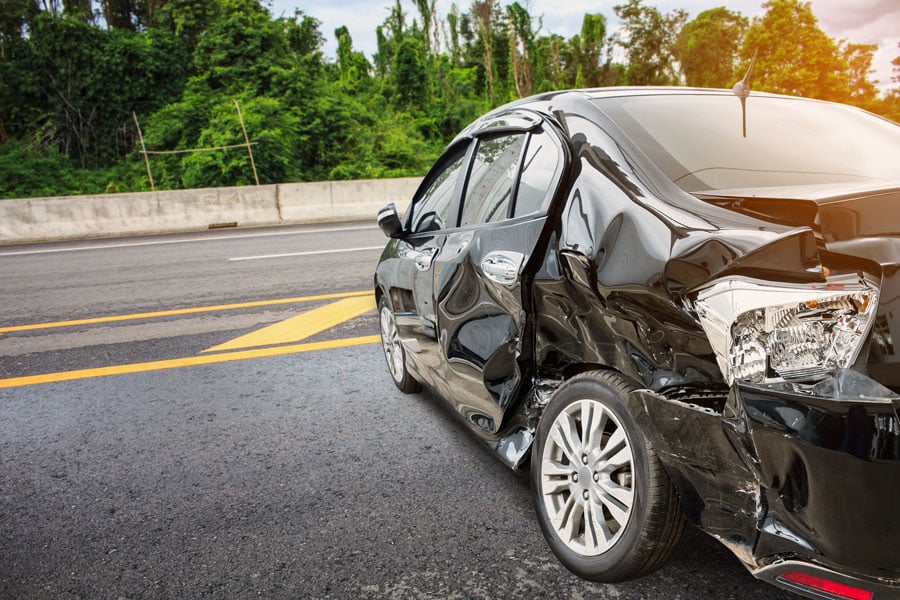Written By: Jonathan Farine and Daniel Garas, Summer Student
T-Bone car accident: One of the most dangerous types of car accidents you can be involved in is the T-bone collision. These collisions occur when one vehicle drives directly into the side of another vehicle, forming the shape of a “T”. A T-bone car accident is especially dangerous for the occupants of the vehicle that is struck on the side, as the driver or passenger side doors offer little protection from the force of an oncoming vehicle.
Because of this, people often assume that the driver that hits the side of the other vehicle is always at fault. However, we need to consider how the T-bone car accident took place to determine who had the right of way and who is at fault.
Thankfully, the Insurance Act[1] includes a regulation called Fault Determination Rules to clarify the degree of fault that each driver would assume in various situations.
Want to test your T-bone legal intuition? For the following scenarios, try to predict how much fault (0%, 25%, 50%, 75%, or 100%) would be attributed to each driver. The answers can be found at the bottom of the page.
THE EASY ONES
Scenario A: Driver 1 is driving through an intersection with a green light. Driver 2 fails to obey the red light and T-bones Driver 1.
Scenario B: Drivers 1 and 2 are approaching an intersection (with no traffic lights or signs) from opposite directions. Driver 2 turns left into the path of Driver 1 who continues straight and T-Bones Driver 2.
GETTING A LITTLE TRICKIER
Scenario C: Driver 1 is approaching an intersection intending to turn left. Driver 2 is following Driver 1. The roadway they are driving on is one lane in each direction. Driver 2 attempts to pass Driver 1 as Driver 1 begins a left turn at the intersection. Driver 2 T-bones Driver 1.
Scenario D: The same as scenario C, except Driver 1 is turning left into a private road or driveway, and not an intersection.
THE FINAL EXAM
Scenario E: Drivers 1 and 2 approach an all-way stop intersection from perpendicular directions. After stopping, they both enter the intersection and are involved in a T-bone collision. (Hint: it depends)
Now that you’ve scrolled down to check the answers, we can see that the driver of the vehicle that hits the side of another vehicle is not always at fault. In fact, four of the five scenarios that we considered would result in the driver who was hit on the side being partially or fully at fault for the collision.
ADDITIONAL FACTORS TO CONSIDER
- Even if a driver has the right of way, if they were breaking the law (e.g. by speeding, driving intoxicated, etc.) then their level of fault will likely increase.
- Similarly, if they were distracted while driving and could have otherwise easily avoided the accident, their level of fault will likely increase.
- Statements from any witnesses to the collision will likely influence the determination of fault.
INJURED IN A T-BONE COLLISION?
If you or someone you know has been injured in a T-Bone or other motor vehicle accident, contact the lawyers at McLeish Orlando LLP for a free consultation.
ANSWERS
Scenario A Answer: Driver 2 is 100% at fault.[2]
Scenario B Answer: Driver 2 is 100% at fault.[3]
Scenario C Answer: Driver 1 is 25% at fault and Driver 2 is 75% at fault.[4]
Scenario D Answer: Both drivers are 50% at fault.[5]
Scenario E Answer: If the drivers arrived at the stop sign at the same time and stopped, then the driver that is to the left is 100% at fault as the driver at the right-most stop sign had the right of way.[6] If it cannot be established who arrived at the intersection first, then both drivers are 50% at fault.[7]
[1] Insurance Act, R.S.O. 1990, c. I.8
[2] Fault Determination Rules, at Rule 15(2).
[3] Fault Determination Rules, at Rule 12(5).
[4] Fault Determination Rules, at Rule 10(5).
[5] Fault Determination Rules, at Rule 10(6).
[6] Fault Determination Rules, at Rule 14(6).
[7] Fault Determination Rules, at Rule 14(7).






